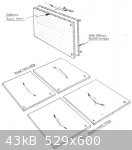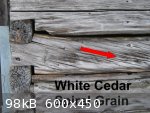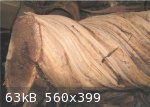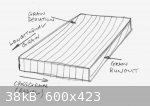| Pages:
1
2 |
hamed
Oud Junkie
    
Posts: 293
Registered: 1-18-2005
Location: Seattle, Washington
Member Is Offline
Mood: Iss'al rouhak
|
|
Multiple piece soundboard?
Dear Friends,
I recently got into a serious argument with a guitar player/dealer who was very assertive in claiming that a book matched soundboard is the only
option for a high quality instrument. I'm not an expert, but have seen high quality ouds that are made with 3 or 4 piece soundboards. I own a oud
from a very reputable maker which has a 3 piece face. Does this really affect the sound, or is it merely aesthetic?
I would think that as long as the wood is the same relative density and thickness it should not make a difference.
I would appreciate any input!
Thank you
|
|
|
Ararat66
Oud Junkie
    
Posts: 1025
Registered: 11-14-2005
Location: Portsmouth, UK
Member Is Offline
Mood: mellow yellow
|
|
Hamed
If it sounds great and plays well then it doesn't matter if it is an 8 piece soundboard I reckon. I've never seen this on guitars but have on
ouds.
Cheers
Leon
|
|
|
hamed
Oud Junkie
    
Posts: 293
Registered: 1-18-2005
Location: Seattle, Washington
Member Is Offline
Mood: Iss'al rouhak
|
|
Thanks Leon,
that was always my attitude as well, i just want to know if there is any evidence of a bookmatched top being superior. It seems that in the guitar
community multiple piece tops are frowned upon
|
|
|
DoggerelPundit
Oud Junkie
    
Posts: 141
Registered: 7-28-2010
Location: Pacific Northwest
Member Is Offline
Mood: Odar
|
|
And there are always, er, combinations of combinations. Right now I am taking a break from playing one of the finest sounding instruments from
Mustafa Copcuoglu I have ever heard (out of about 13 or 14 so far). This is a 2001 with a 4 piece, double book-ended face. That is, the larger center
pieces are book-ended, as are the smaller edge pieces. Perhaps many 4 piece ouds are faced in this fashion. It does make sense.

-Stephen
|
|
|
jdowning
Oud Junkie
    
Posts: 3485
Registered: 8-2-2006
Location: Ontario, Canada
Member Is Offline
Mood: No Mood
|
|
Better a soundboard made from 3 (or more) pieces of high quality resonant wood (not necessarily matching) - chosen by a knowledgeable luthier - than
one made from two mediocre book matched pieces selected by the luthier supply trade.
Ibn al-Tahhan al Musiqi writing in the 14th C states that the sound board of an oud should be made from 2 or 3 pieces rather than of 1 piece. He makes
no mention about any need for book matching. So more would seem to be better than less.
Some of the surviving lutes by the most prominent luthiers of the 16th and 17th C have sound boards made up of more than 2 pieces dependent upon the
size of the lute - smaller pieces often being added to make up the width.
My old Egyptian oud has a four piece soundboard. I notice that some Nahats have 6 piece soundboards.
|
|
|
Microber
Oud Junkie
    
Posts: 853
Registered: 1-20-2006
Location: Belgium - Liège
Member Is Offline
Mood: No Mood
|
|
Very interesting topic.
But what does mean 'book matched pieces of wood'?
Robert
|
|
|
jdowning
Oud Junkie
    
Posts: 3485
Registered: 8-2-2006
Location: Ontario, Canada
Member Is Offline
Mood: No Mood
|
|
The attached sketch may help to explain 'book matching'
The thick sound board blank is cut down the middle and the two pieces opened like a book and the edges AA (or BB) joined together to make the sound
board. The grain pattern is, therefore, symmetrical about the centre line. Alternatively the two halves may be joined BA (or AB) - and so are not book
matched.
Most trees grow with a spiral grain ('following the sun') and it is rare for a tree to grow with perfectly straight grain. When a tree is sawn into
sound board blanks any spiral grain will be cut across becoming evident as grain 'run out' viewed along the thin edge of the sound board blank-
difficult to see - but a fault best avoided. Lower grade sound boards purchased commercially will have some degree of grain run out so that when
bookmatched the grain run out is mismatched. This defect can be overcome to a certain extent by not book matching the two halves so that the grain run
out match.
The best sound board material has little or no grain run out - determined by splitting the wood along the grain into billets or wedges. This way any
spiral grain becomes evident and can then be avoided.

|
|
|
Microber
Oud Junkie
    
Posts: 853
Registered: 1-20-2006
Location: Belgium - Liège
Member Is Offline
Mood: No Mood
|
|
Hey John,
Fantastic explanation... as usual !
Thank you very much.
Always something new to learn with woodworking.
Robert
|
|
|
jdowning
Oud Junkie
    
Posts: 3485
Registered: 8-2-2006
Location: Ontario, Canada
Member Is Offline
Mood: No Mood
|
|
My pleasure Robert.
|
|
|
freya
Oud Junkie
    
Posts: 275
Registered: 2-8-2004
Location: Asheville NC
Member Is Offline
Mood: Happy in the mountains of WNC
|
|
I have read that Torres did not care about matched tone wood sets but just used pieces that he considered, individually, to have good sound. I've
never seen a Torres up close so I can't speak from first hand but, personally, I would chose individual pieces for tone first and consider
bookmatching nice-to-have and a plus visually all other thing equal.
|
|
|
hamed
Oud Junkie
    
Posts: 293
Registered: 1-18-2005
Location: Seattle, Washington
Member Is Offline
Mood: Iss'al rouhak
|
|
Thank you for the input guys.
Hamed
|
|
|
jdowning
Oud Junkie
    
Posts: 3485
Registered: 8-2-2006
Location: Ontario, Canada
Member Is Offline
Mood: No Mood
|
|
The attached article by the late Rémy Gug (Comm 1011, published in FoMRHI, October 1990) about the selection of instrument sound board woods in
earlier times may be of interest under this topic.
I have to wonder how the timber selection process for instrument sound boards is undertaken today by suppliers to the luthier trade?
Attachment: R.Gug Resonance Wood Article.pdf (933kB)
This file has been downloaded 476 times
|
|
|
jack
Oud Junkie
    
Posts: 116
Registered: 4-5-2010
Member Is Offline
|
|
This is a lateral deviation on this topic, but thought it was interesting enough to share. I play the ukulele as well as the oud. In a video I
recently watched about Kamaka Ukuleles (one of the oldest uke makers in Hawaii) I found out that this company has hired deaf people for many years to
be the ones who choose the best woods for the soundboard, and, I suppose, the body as well. These folks 'feel' the vibrational qualities of the wood.
It is amazing that those who can't hear are the ones who choose the wood that is used by those who can hear. You can see this on the video, it's near
the end http://youtu.be/SYjUOOyWsjs
|
|
|
jdowning
Oud Junkie
    
Posts: 3485
Registered: 8-2-2006
Location: Ontario, Canada
Member Is Offline
Mood: No Mood
|
|
This additional information related to spiral growth in trees that results in grain 'run out' in sawn timber may be of interest.
The Northern European carpenters who once built houses of logs - many beautiful examples surviving to this day - were careful in the selection of
their logs. They observed that trees grew sometimes with straight grain but more often with spiral growth that ranged from slight to extreme.
The old Bavarian carpenters classified spiral growth as 'against the sun' (right hand twist) or 'with the sun' (left hand twist) and selected their
logs accordingly - rejecting 'with the sun' growth logs as unsuitable for building because these logs are unstable tending to 'untwist' over time
causing distortion of the log walls of a structure.
Grain twist was determined in the forest prior to felling a tree by stripping some of the bark to reveal any spiral growth. The right hand was placed
against the tree and if the grain was in the direction of the little finger the spiral growth was right handed and the log considered suitable for
building purposes.
The attached images show how the right hand is used to determine direction of the spiral grain as well as some examples of spiral growth found on my
property - a standing dead white pine tree, extreme spiral growth in Vine wood and extreme twist in a white cedar timber in one of my old log
buildings (mid 19th C) - all with right handed 'against the sun' twist. The logs in my old buildings all seem to be relatively straight grained or
with 'against the sun twist' - all according to the dictates of the old European traditions.
So, all of this begs an interesting question. Do suppliers of sound board woods to the luthier trade also make a distinction between stable logs (with
some degree of right hand twist) - but reject outright those left hand twist unstable logs?
I somehow doubt it!
Does it make any difference? Probably nobody knows or even cares in this day and age!





|
|
|
Ararat66
Oud Junkie
    
Posts: 1025
Registered: 11-14-2005
Location: Portsmouth, UK
Member Is Offline
Mood: mellow yellow
|
|
That's really interesting - thanks.
Leon
|
|
|
jdowning
Oud Junkie
    
Posts: 3485
Registered: 8-2-2006
Location: Ontario, Canada
Member Is Offline
Mood: No Mood
|
|
This afternoon I came across a series of 6 videos by internationally renowned master guitar maker Jose Romanillos - all about selection of woods for
soundboards.
Romanillos works in the mid 19th C Spanish guitar making tradition of Torres - but his observations apply just as well to ouds, lutes and other
related traditional instruments.
He talks about and demonstrates grain 'run out and the benefit of multiple piece sound boards (part 4 - How to make the Better Guitar Top) among many
other aspects of interest - admirably well presented and of particular relevance to this thread.
http://www.customguitarvideo.com.
|
|
|
jdowning
Oud Junkie
    
Posts: 3485
Registered: 8-2-2006
Location: Ontario, Canada
Member Is Offline
Mood: No Mood
|
|
The previously posted link to the José Romanillos videos at the custom guitar videos web site does not seem to be working. However all of the videos
are currently available on YouTube. Just do a Google search for 'Jose Romanillos' and all will be revealed.
|
|
|
farukturunz
Oud Junkie
    
Posts: 569
Registered: 8-16-2005
Location: Istanbul, Turkey
Member Is Offline
Mood: hopeful
|
|
Thank you hamed for this thread: it started a brain storming on the subject. Of course we learn much from the contributors.
May part of the answer related to the allocation of the forests on the planet?
Also... may the real reason be different? Like shortage of wood wide enough to make the soundboards book matched...
Regards
|
|
|
jdowning
Oud Junkie
    
Posts: 3485
Registered: 8-2-2006
Location: Ontario, Canada
Member Is Offline
Mood: No Mood
|
|
No question that multiple piece soundboards are due to a shortage of good quality tonewoods (high elasticity, low density, straight grain with no run
out etc) in dimensions wide enough to make a two piece bookmatched sound board. Multiple piece sound boards will no doubt become more common on even
the best instruments as the softwood forests become increasingly and rapidly depleted.
However multiple piece sound boards have been around for centuries I suspect not because of a shortage of material but because an acoustically and
structurally superior soundboard can be made from carefully selected multiple pieces compared to one made from two bookmatched pieces. Two piece
soundboards I suspect has a lot to do with customer expectation and cosmetics but may not be the way to go for the best sounding instrument.
There is an interesting paper by Mark French and Rod Handy, Dept. of Mechanical Engineering Technology, Purdue University on "Sustainability and Life
Cycle Management in Guitar Production" addressing the problem of material supply to the luthier trade and use of alternative materials. They note that
some prominent guitar makers have built superior instruments (with multiple piece sound boards) using only structural graded wood (Spruce and Cedar
studs) purchased from local building suppliers. This can be done by careful selection of the woods (if the supplier will allow it!).
A good demonstration of undesirable grain runout in so called 'tonewood' can be seen in Part 2 (about halfway in) of the six part series by José
Romanillos previously mentioned. He shows a commercially supplied violin top plate sawn billet that he tried to hand split down the middle but failed
due to excessive run out caused by spiral growth ('against the sun' spiral growth in this case). Had this been carved into a violin top (or sawn down
the middle to make a two piece bookmatched guitar sound board) not only would it have been structurally weak due to the grain run out but sound
transmission along the grain would also have been adversely affected.
|
|
|
abusin
Oud Junkie
    
Posts: 442
Registered: 3-23-2006
Location: Manchester England
Member Is Offline
Mood: Ya Fuadi La Tasal
|
|
very interesting,
Thanks Hamed and John
Best Regards
Awad
|
|
|
hamed
Oud Junkie
    
Posts: 293
Registered: 1-18-2005
Location: Seattle, Washington
Member Is Offline
Mood: Iss'al rouhak
|
|
The video links to the luthier Jose Ramanillos do provide insight on the subject as Jdowning mentioned. Here is another link to one of them. http://www.youtube.com/watch?v=59Vsdgg00Gs&feature=relmfu
He does shed light on the subject in this series. It would seem to me that tonality is not affected so much by the number of pieces of a soundboard,
and the notion of 2 piece bookmatching is for aesthetics.
I was also looking at some posts in various guitar forums, any time a picture of a guitar with more than 2 pc soundboard would be posted, the members
would give negative comments as to how "ugly" the instrument is without having heard the sound.
I'm sure this negativity is somewhat perpetuated by the lumber industry in order to sell more wood.
|
|
|
jdowning
Oud Junkie
    
Posts: 3485
Registered: 8-2-2006
Location: Ontario, Canada
Member Is Offline
Mood: No Mood
|
|
.... and you will often notice when looking at two piece guitar tops that under incident lighting one half of the sound board appears to be a darker
shade than the other. This is due to grain 'runout' in the soundboard wood that should not be evident in so called 'tonewood' of the highest (and most
expensive) select grade. The highest grades should come from hand split billets that exhibit (rarely) no spiral growth. However as this is a time
consuming, costly process the majority of sound board blanks no doubt come from quarter sawn logs where some run out (and less than perfect quartering
of the grain) is inevitable. Some suppliers I note are at least honest in stating that their highest select grade of sound board wood may contain
minimal (but not zero) grain runout.
It is a detail that could - in the hands of an experienced luthier - make all the difference between a good instrument and one that is outstanding
acoustically.
It is of interest to contemplate that most of the stands of trees (in North America and Canada at least) that might potentially produce 'tonewood'
sound boards are sold to major lumber companies who quickly and economically convert the logs to graded lumber in great quantity for structural
purposes (building houses etc) all readily available from local building suppliers as the familiar 2x4's, 2x6's etc. This lumber is marked as 'SPF' as
the wood is a mixture of species (Spruce, Pine and Fir) - White Spruce, Engelmann Spruce, Lodgepole Pine and Alpine Fir. So - sitting in your local
wood yard there may be a hidden treasure - the odd piece that may be perfect tonewood material albeit of smaller dimensions than would make a two
piece sound board but which might make up into a fantastic multiple piece sound board.
|
|
|
jdowning
Oud Junkie
    
Posts: 3485
Registered: 8-2-2006
Location: Ontario, Canada
Member Is Offline
Mood: No Mood
|
|
There is an interesting research paper 'Acoustic Properties in Arizona Cypress Logs: a Tool to Select Wood for Sounding Board' by Roohnia et al.
Department of Wood Science and Technology, Islamic Azad University, Iran that investigates how the acoustical properties of Iranian cedar might vary
across the diameter of a log by acoustic testing of samples at four locations from the centre to the outside. (see BioResources.com - "Acoustics of
Cypress Logs", BioResources 6(1) pages 386-399 - free to view)
The authors conclude that the best sounding board material comes from the outside quarter of a log with growth ring width of less than 2 mm taken from
logs of 400 mm diameter or larger. They also conclude that visual inspection alone is not a sufficiently reliable method for tonewood selection (only
50% of the visually selected wood from the 4th quarter specimens proved to be suitable for soundboards from the acoustic tests).
So this may confirm the reason for multiple piece sound boards - of necessity made up from relatively narrow strips of the best material contained in
a log of large diameter. (logs of only 400 mm diameter would likely not yield wide enough strips of the best wood?).
Of course, the old luthiers would not have the benefit of modern scientific tools to undertake acoustic tests but would use the tactile methods of
flexing sound board wood to assess stiffness, to evaluate relative density and, by tapping the wood to evaluate vibrational damping - selecting those
woods that 'ring' with good sustain - methods still used today by some experienced luthiers.
This research paper is also of general interest in reviewing work by others in the field of acoustic testing of wood and explaining the basic science
involved.
|
|
|
hamed
Oud Junkie
    
Posts: 293
Registered: 1-18-2005
Location: Seattle, Washington
Member Is Offline
Mood: Iss'al rouhak
|
|
Hey jdowning,
Regarding the issue of grain runout, look at this link to Marcel Khalife, there is a close up of his oud at 0:47, http://www.youtube.com/watch?v=r8mpj213eZU&feature=related
you can notice the grain runout where the 2 middle pieces are joined. I was at a Marcel Khalife concert yesterday in the 3rd row, looking at his oud
i am sure that it is made of 4 pieces, and this is a great sounding oud i think everyone would agree. However, i wonder why the luthier who made his
oud chose to use this particular wood with the runout bieng so clear.
|
|
|
jdowning
Oud Junkie
    
Posts: 3485
Registered: 8-2-2006
Location: Ontario, Canada
Member Is Offline
Mood: No Mood
|
|
What you are referring to hamed is what I would define as longitudinal grain deviation (from being perfectly straight). Grain 'run out' is due to
spiral growth in a tree that can only be visually detected by splitting a log of potential sound board wood radially.
The attached rough sketch of a quarter cut section of wood may help to clarify the difference between 'longitudinal grain deviation' and 'longitudinal
grain run out'.
Acoustic testing of wood longitudinally or parallel to the grain has shown that any grain deviation from perfectly straight results in a reduction in
stiffness longitudinally and hence a reduction in acoustic 'goodness' - stiffer wood consistent with also being light in weight is generally
recognised as being best acoustically.
Some researchers have reported that grain 'runout' can cause significant reduction in acoustic goodness (whereas grain deviation - according to my
limited tests to date - would seem to be less important (provided that there is also no grain 'run out' involved). So, a sound board with some crooked
longitudinal grain - provided there is little or no grain runout - might be perfectly good acoustically (in the hands of an experienced luthier)
I note that the oud in the video is a 'non traditional' floating bridge 'bashir' type so the optimum mechanical properties of the sound board material
may be quite different from those of a traditional fixed bridge oud?
Note also that sound board cross grain (radial axis) stiffness can also be a significant factor in sound board selection. It is said that some guitar
makers aim for high cross grain stiffness in the central part of a sound board and lower cross grain stiffness for the outer parts (implying a
multiple-piece sound board). Perhaps the same is true for some oud sound boards?

|
|
|
| Pages:
1
2 |